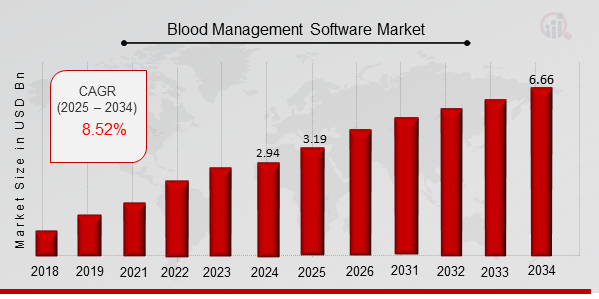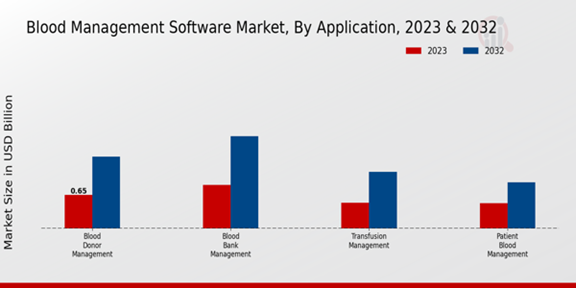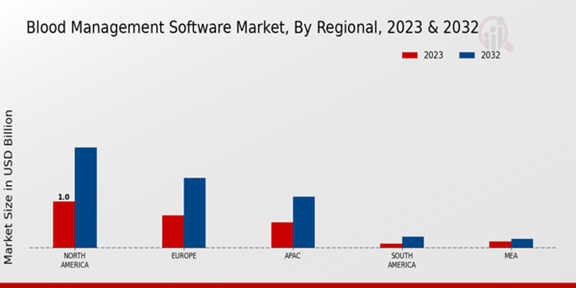Blood Management Software Market Overview
As per MRFR analysis, the Blood Management Software Market Size was estimated at 2.94 (USD Billion) in 2024. The Blood Management Software Market Industry is expected to grow from 3.19 (USD Billion) in 2025 to 6.66 (USD Billion) till 2034, at a CAGR (growth rate) is expected to be around 8.52% during the forecast period (2025 - 2034).
Key Blood Management Software Market Trends Highlighted
The Blood Management Software Market is being driven by several key factors that support its growth. Increasing demand for blood and blood products, particularly in hospitals and transfusion centers, is a significant factor. Moreover, stringent regulations surrounding blood safety enhance the adoption of advanced software solutions. The emphasis on improving operational efficiencies and reducing errors in blood management processes is leading healthcare providers to seek innovative technology. As healthcare systems strive to optimize blood usage and minimize waste, there is a growing demand for sophisticated software that can provide real-time data and analytics.Opportunities in the blood management software space are emerging as healthcare organizations look to integrate the software with existing systems. With the rise in digital health initiatives, companies that can offer cloud-based solutions or mobile applications have a chance to capture more market share. Additionally, the increasing focus on personalized medicine opens avenues for software that can track donor health data and improve donor experience. There is also potential in developing solutions tailored for emerging markets, where there is an increasing need for organized blood management services. In recent times, the trend toward digitization in healthcare has transformed the landscape of blood management.The integration of artificial intelligence and machine learning into these software solutions is enhancing predictive analytics and decision-making processes. Enhanced interoperability with electronic health records is becoming increasingly critical. Furthermore, there is a notable push toward enhancing user experience through intuitive interfaces. As healthcare providers continue to prioritize patient safety and operational efficiency, the evolution of blood management software is expected to accelerate, fostering innovation and improvement in overall blood management practices.

Source: Primary Research, Secondary Research, MRFR Database and Analyst Review
Blood Management Software Market Drivers
Increasing Demand for Efficient Blood Management Systems
The Blood Management Software Market is witnessing a significant surge in demand for efficient blood management systems. This is largely due to the increasing need for hospitals and blood banks to optimize their blood donation, storage, and distribution processes. Improved efficiency in managing blood resources directly contributes to better patient outcomes and ensures that the right blood type is available for transfusion at any given time.As healthcare facilities strive to enhance their operational efficiencies, the adoption of sophisticated blood management software solutions becomes essential. Additionally, as the global population continues to grow, the demand for blood transfusions is expected to rise, further driving the need for advanced software that can handle complex logistics and maintain regulatory compliance. The Blood Management Software Market Industry will thus see continuous innovations aimed at improving data management, reducing waste, and enhancing data-sharing capabilities among healthcare providers.Furthermore, with an increase in surgical procedures and emergency medical services, there’s a growing realization of the importance of effective blood management in ensuring timely and accessible care, which fosters a positive environment for the market to expand robustly.
Technological Advancements in Blood Management
Technological advancements play a vital role in shaping the Blood Management Software Market Industry. Innovations such as real-time tracking of blood products, automated inventory management, and advanced data analytics are crucial for enhancing blood management processes. These advancements not only improve operational efficiencies but also offer better decision-making capabilities for healthcare providers. The integration of artificial intelligence and machine learning into blood management solutions enables predictive analytics, helping facilities anticipate demand trends and manage blood supplies efficiently.
Rising Awareness and Regulations Related to Blood Safety
With increasing public awareness regarding blood safety and regulatory requirements, healthcare institutions are compelled to adopt advanced blood management solutions. The Blood Management Software Market Industry is adapting to these regulations by providing software that meets compliance standards, tracks blood origin, and ensures safety protocols are followed. This trend not only supports patient safety but also boosts the overall perception of healthcare quality in managing blood resources.
Blood Management Software Market Segment Insights:
Blood Management Software Market Application Insights
The Application segment of the Blood Management Software Market is pivotal for enhancing the efficiency and effectiveness of blood collection, storage, and transfusion processes. In 2023, the valuation for the overall market stood at 2.49 billion USD, with this segment contributing significantly to its growth. Blood Donor Management, valued at 0.65 billion USD in 2023, plays a crucial role in the recruitment and retention of blood donors, facilitating a smoother supply chain for blood banks. As the demand for blood continues to rise, advancements in donor management systems are expected to simplify donor interaction, record keeping, and appointment scheduling, which allows this segment to demonstrate substantial growth potential, reaching an anticipated 1.4 billion USD in 2032.
Blood Bank Management, accounting for a valuation of 0.85 billion USD in 2023, is another key area, enabling hospitals and donation centers to manage the inventory, testing, and distribution of blood products effectively. This sector's significance stems from its ability to reduce wastage, optimize inventory levels, and ensure regulatory compliance, which is increasingly important in today's healthcare landscape. It is projected to expand to 1.8 billion USD by 2032, reflecting the rising need for advanced management systems in blood storage and processing to meet clinical demands efficiently.
Transfusion Management, while valued at 0.5 billion USD in 2023, is essential for patient safety and optimal use of blood products. This segment enables healthcare providers to track blood transfusions closely, ensuring that correct matches and dosages are administered, thereby minimizing the risks associated with transfusions. Its expected growth to 1.1 billion USD in 2032 indicates a heightened focus on improving transfusion practices across healthcare institutions.
Patient Blood Management, valued at 0.49 billion USD in 2023, focuses on minimizing unnecessary transfusions and improving patient outcomes through better blood management protocols. With the industry's increasing emphasis on personalized medicine and cost-efficiency, this segment is becoming more relevant, aiming to reach 0.9 billion USD in 2032. It aims to optimize blood use within hospitals, thereby not only ensuring patient safety but also reducing healthcare costs, thus enhancing its importance within the Blood Management Software Market industry. The market growth within these applications is driven by the increasing prevalence of chronic diseases, the rising number of surgical procedures requiring blood transfusions, and an overall increase in demand for efficient blood management solutions.
Challenges such as stringent regulatory requirements, high implementation costs, and data security concerns also impact the growth trajectory of these applications, yet they bring forth opportunities for innovation and development to improve efficiency and patient care in the long run. The overall Blood Management Software Market data reveals a promising landscape for stakeholders involved in these application segments, with robust market statistics serving as an indicator of a thriving industry poised for significant advancements and expansion in the subsequent years.

Source: Primary Research, Secondary Research, MRFR Database and Analyst Review
Blood Management Software Market Deployment Type Insights
The Blood Management Software Market is poised for significant growth, particularly in the Deployment Type segment, which includes On-Premise, Cloud-Based, and Hybrid solutions. By 2023, the market has been valued at approximately 2.49 billion USD, showcasing its importance in the healthcare sector. The On-Premise model remains a traditional choice for many facilities due to its control and security benefits, while Cloud-Based solutions are gaining traction for their scalability, cost-effectiveness, and ease of access. The Hybrid approach is particularly valuable as it combines the strengths of both On-Premise and Cloud-Based systems, offering flexibility to healthcare providers.This diversification within the deployment types supports unique operational needs, driving overall market growth. The Blood Management Software Market data highlights that demand for efficient inventory management, compliance with safety regulations, and the necessity for real-time data analysis are critical factors fueling this market's progress. Furthermore, the increasing incidence of blood-related diseases presents an opportunity for innovation and expansion within this segment, emphasizing the vital role of these software solutions in enhancing blood bank operations and patient care.
Blood Management Software Market End User Insights
The Blood Management Software Market is expected to reach a valuation of 2.49 USD billion in 2023, showcasing significant interest in its End User segment. This segment comprises essential entities such as hospitals, blood donation centers, diagnostic laboratories, and research institutions. Hospitals play a crucial role as they often handle the majority of blood management operations, making their efficiency significantly impactful on patient care and operational workflow. Blood donation centers are important as they directly influence the availability and quality of blood supplies, while diagnostic laboratories contribute by ensuring the safety and compatibility of blood products.Research institutions also hold significance as they drive innovation and advancements in blood management practices. The growing emphasis on efficient blood management processes due to increasing demand for safe transfusions is a key driver of market growth. While operational challenges, such as data integration and regulatory compliance, persist, opportunities for enhanced technologies and automation continue to arise within each end-user category, shaping the future landscape of the Blood Management Software Market.
Blood Management Software Market Functionality Insights
The Blood Management Software Market is poised for significant growth, valued at approximately 2.49 billion USD in 2023, and is projected to expand further as demand increases. A key aspect of this market is its functionality, which plays a crucial role in the overall efficiency and effectiveness of blood management processes. Essential functionalities include inventory management, which helps healthcare providers maintain optimal stock levels of blood products while minimizing waste. Reporting and analytics functionality offers insights that drive data-based decision-making, ultimately improving patient care.Compliance management ensures adherence to stringent regulations, thereby enhancing safety in blood transfusions. Data management is vital for securely handling sensitive information and facilitating accurate tracking and reporting of blood use. These functionalities not only streamline operations but also support the overall objectives of the Blood Management Software Market by fostering operational efficiency and improving patient outcomes. As the industry continues to grow, advancements in these areas will be essential for addressing modern healthcare challenges effectively.
Blood Management Software Market Regional Insights
The Blood Management Software Market exhibits significant regional variations in revenue, with North America leading with a valuation of 1.0 USD Billion in 2023, projected to grow to 2.15 USD Billion by 2032. This prominent position is driven by advanced healthcare infrastructure, increasing technological adoption, and rising demand for efficient blood management solutions. Europe follows with a valuation of 0.7 USD Billion in 2023, expected to reach 1.5 USD Billion by 2032, showing a strong focus on improving patient care and blood safety standards across various countries.APAC represents a growing market, with a 2023 valuation of 0.55 USD Billion projected to rise to 1.1 USD Billion, fueled by expanding healthcare facilities and increased investments in blood management technologies. South America and MEA, although smaller segments, are witnessing gradual growth; South America is valued at 0.1 USD Billion in 2023, anticipated to reach 0.25 USD Billion by 2032, indicative of emerging healthcare needs. Similarly, MEA is valued at 0.14 USD Billion in 2023, with an expected rise to 0.2 USD Billion as healthcare systems progressively adopt such software.The overall segmentation highlights varying trends and opportunities across these regions, driven by local healthcare demands and advancements in technology.

Source: Primary Research, Secondary Research, MRFR Database and Analyst Review
Blood Management Software Market Key Players and Competitive Insights:
The Blood Management Software Market is experiencing significant growth as healthcare organizations increasingly recognize the importance of effective blood management in enhancing patient care and operational efficiency. This market encompasses software solutions designed to assist hospitals and blood banks in managing the entire lifecycle of blood products, from donation and testing to transfusion and inventory management. Competitive insights reveal that a range of players are vying for dominance in this sector, each leveraging advanced technology, innovation, and strategic partnerships to enhance their offerings. Factors such as regulatory compliance, patient safety, and the integration of artificial intelligence and data analytics into blood management systems are pivotal in shaping the competitive landscape, driving companies to differentiate themselves through unique features and customer value propositions.Meditech has established a substantial presence within the Blood Management Software Market, leveraging its extensive experience in healthcare solutions to deliver robust and integrated blood management applications. The strength of Meditech lies in its commitment to providing comprehensive interoperability with other health systems, thereby facilitating seamless data exchange across various stages of blood management. This capability not only enhances the accuracy of blood inventory tracking but also aids in optimizing transfusion safety and compliance with regulatory standards. Furthermore, Meditech emphasizes user-friendly interfaces and strong support services, allowing healthcare professionals to efficiently manage blood utilization while focusing on improving patient outcomes. The company's dedication to continuous innovation and responding to the evolving needs of healthcare providers positions it well in a competitive environment.Allscripts is another key player in the Blood Management Software Market, recognized for its focus on creating integrated healthcare solutions that enhance the efficiency of blood services. The company boasts advanced software solutions designed to automate and streamline blood management processes, thus reducing the potential for human error and improving overall operational proficiency. Allscripts' strength lies in its ability to integrate with electronic health records and other health management tools, allowing for a holistic approach to patient care and blood product management. By harnessing data analytics and reporting capabilities, Allscripts enables healthcare organizations to effectively monitor blood inventory levels and transfusion practices, leading to optimized resource allocation and patient safety. Its focus on innovation and collaboration with healthcare providers further strengthens its competitive stance in the market, contributing to improved blood management practices across various health institutions.
Key Companies in the Blood Management Software Market Include:
- Meditech
- Allscripts
- Lifeblood
- InterSystems
- Omega Healthcare
- Blood Bank Technologies
- Hemocue
- Cerner
- McKesson
- Software Development Technologies
- Oracle
- Woosley
- Kelsan
- Epic Systems
- SCC Soft Computer
Blood Management Software Market Industry Developments
Recent developments in the Blood Management Software Market indicate a growing emphasis on technological advancements and strategic partnerships among key players like Meditech, Allscripts, and Cerner. Companies are focusing on enhancing data analytics capabilities and streamlining blood resource management to improve efficiency in healthcare delivery. Current affairs highlight the rising demand for integrated solutions that can support blood bank operations and enhance patient safety through real-time tracking and reporting. Mergers and acquisitions have been notable, with companies like McKesson exploring collaborative opportunities to expand their service offerings. The market is experiencing significant growth, driven by the increasing need for effective inventory management systems and regulatory compliance, pushing companies such as Epic Systems and Omega Healthcare to innovate and capture larger market shares. As the valuation of firms in this sector rises, investments in research and development are anticipated to further drive advancements in software capabilities, thus positively impacting overall market dynamics. With players like Blood Bank Technologies, Hemocue, and InterSystems actively participating, the competitive landscape remains robust and progressive, fostering an environment conducive to growth and expansion.
Blood Management Software Market Segmentation Insights
Blood Management Software Market Application Outlook
- Blood Donor Management
- Blood Bank Management
- Transfusion Management
- Patient Blood Management
Blood Management Software Market Deployment Type Outlook
- On-Premise
- Cloud-Based
- Hybrid
Blood Management Software Market End User Outlook
- Hospitals
- Blood Donation Centers
- Diagnostic Laboratories
- Research Institutions
Blood Management Software Market Functionality Outlook
- Inventory Management
- Reporting and Analytics
- Compliance Management
- Data Management
Blood Management Software Market Regional Outlook
- North America
- Europe
- South America
- Asia Pacific
- Middle East and Africa
| Report Attribute/Metric |
Details |
|
Market Size 2024
|
2.94 (USD Billion)
|
|
Market Size 2025
|
3.19 (USD Billion)
|
|
Market Size 2034
|
6.66 (USD Billion)
|
|
Compound Annual Growth Rate (CAGR)
|
8.52 % (2025 - 2034)
|
|
Report Coverage
|
Revenue Forecast, Competitive Landscape, Growth Factors, and Trends
|
|
Base Year
|
2024
|
|
Market Forecast Period
|
2025 - 2034
|
|
Historical Data
|
2020 - 2024
|
| Market Forecast Units |
USD Billion |
| Key Companies Profiled |
Meditech, Allscripts, Lifeblood, InterSystems, Omega Healthcare, Blood Bank Technologies, Hemocue, Cerner, McKesson, Software Development Technologies, Oracle, Woosley, Kelsan, Epic Systems, SCC Soft Computer |
| Segments Covered |
Application, Deployment Type, End User, Functionality, Regional |
| Key Market Opportunities |
Increasing demand for blood safety, Growth in surgical procedures, Advanced data analytics integration, Rise of cloud-based solutions, Expanding regulatory standards compliance |
| Key Market Dynamics |
Rising demand for efficient tracking, Increasing regulatory compliance requirements, Technological advancements in software, Growing focus on transfusion safety, Expanding healthcare infrastructure investments |
| Countries Covered |
North America, Europe, APAC, South America, MEA |
Frequently Asked Questions (FAQ) :
By 2034, the Blood Management Software Market is expected to be valued at approximately 6.66 USD Billion.
The market is projected to experience a CAGR of 8.52% during the forecast period from 2025 to 2034.
North America is anticipated to hold the largest market share, with an expected valuation of 2.15 USD Billion by 2032.
The Blood Donor Management application market is projected to reach 1.4 USD Billion by 2032.
Major players in the market include Meditech, Allscripts, Lifeblood, and Cerner, among others.
The Blood Bank Management application is anticipated to be valued at 1.8 USD Billion by 2032.
The Transfusion Management segment is expected to reach a market size of 1.1 USD Billion by 2032.
By 2032, the Patient Blood Management application is expected to be valued at approximately 0.9 USD Billion.
The APAC region is projected to reach a market size of 1.1 USD Billion by 2032.
Technological advancements and increasing demand for efficient blood management solutions are key growth drivers.

















